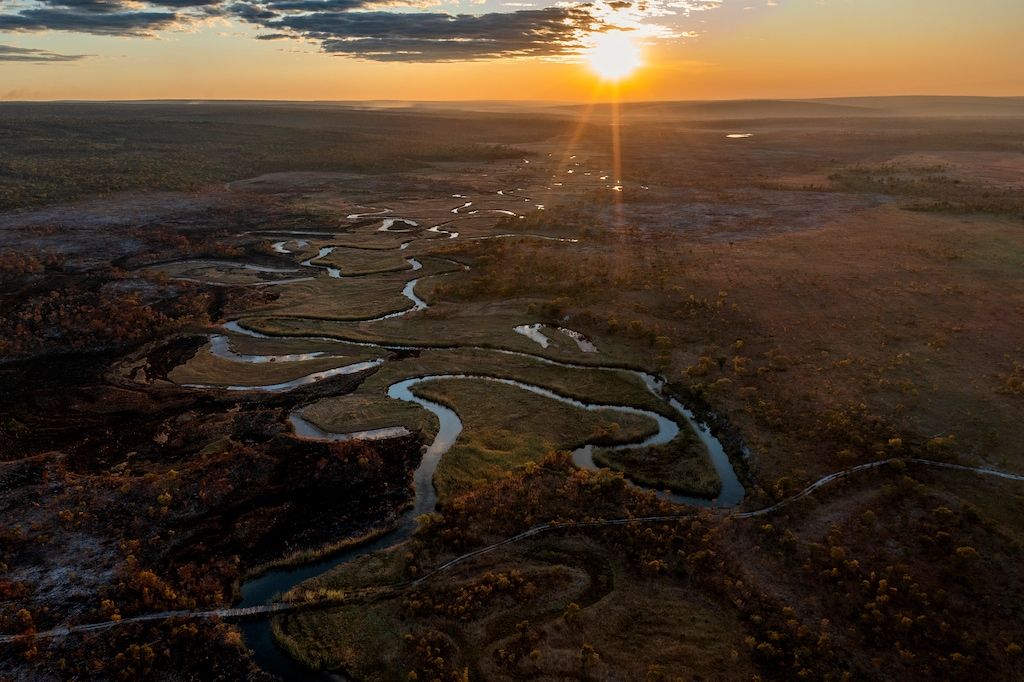Saving earth’s last wild places is the mission of Steve Boyes, who has completed the first of his Great Spine of Africa series of expeditions in protection of humanity and wildlife through the support of the Rolex Perpetual Planet Initiative.
Many of us have probably heard of the mighty Zambezi River, which is the fourth longest river in Africa, and home to big game and exotic birdlife familiar to us thanks to scores of documentaries. What’s barely known, however, is that its drainage basin has never been scientifically documented. Rising in the heart of the continent within Zambia and flowing east into the Indian Ocean, the river is the source of life to over 20 million people in southern Africa and countless species of plants and animals.
Much of the Zambezi’s winding journey, from its marshy origins to the salt waters rushing into the ocean, remains unknown to science. Learning more about its sources and unique ecosystems will help scientists and local communities to protect these areas and the river into the future, building resilience against climate change and human activity. Accomplishing that will be a tremendous undertaking, but there is one man who is up for the challenge: Steve Boyes.
FOR HUMANITY’S SAKE
A Rolex Perpetual Planet Initiative partner, Boyes is a renowned South African ornithologist and conservation biologist, chairman of the Wild Bird Trust, a National Geographic Explorer and a senior TED fellow. Long inspired by Africa’s breathtaking beauty and its creatures great and small, Boyes believes that conservation is the ultimate answer to the betterment of humanity, who rose from this cradle of life some 10,000 years ago. “It is our natural habitat too. We need these last wild places to reconnect with who we really are,” he says.
Much of his life’s work over the past decade has been dedicated to preserving the continent’s great wilderness, especially his research on the Meyer’s parrot, which led him to conduct biodiversity surveys with a team from the National Geographic Okavango Wilderness Project (NGOWP) in the Okavango Delta. Located within Botswana’s Kalahari Desert, it is Africa’s last-surviving intact wetland that is not just home to the world’s largest remaining populations of elephants, but also fearsome hippopotamus that the intrepid explorers had to navigate past annually in their traditional dugout canoes known as mekoro.
Through this groundbreaking project, Boyes and his team were conferred the Rolex National Geographic Explorer of the Year award in 2019. And rightly so, for they discovered 18 undocumented source lakes, vast previously unknown peatlands and new populations of vulnerable species, including the cheetah, elephant and wild dog, along with more than 140 species that are new to science.
PERPETUAL PASSION
In mid-2022, Boyes again demonstrated his unwavering courage and commitment to the cause by embarking on his latest adventure, the Great Spine of Africa series of expeditions, with the support of the Rolex Perpetual Planet Initiative and other partners. Traversing thousands of kilometres of rivers that have never been scientifically documented, the team plans to cover more than 40,000km, equivalent to a journey around the planet, over several years. The mission: to discover crucial information to protect humans and nature dependent on Africa’s vital waterways.
The first expedition, which has been completed, explored the remote Angolan highlands where the Lungwevungu River originates. Boyes and his team believed this tributary of the Zambezi could prove to be its source, an important factor when determining threats to the river. Paddling down the river in their mekoro loaded with scientific equipment, they collected extensive records and data points of human settlements and wildlife sightings that would create a comprehensive baseline of the river’s health and ecosystems.
The work was not just fraught with danger, but also tedious. Every 10km along their 900km route, the researchers used photography and drone footage to survey, monitor and document habitats continuously and in fine detail. They also gathered environmental DNA samples from the water, and examined fish and aquatic invertebrates. The water itself was analysed through systematic measurements of the river’s structure, flow and water quality. This rigorous baseline work was built upon the first NGOWP expedition, and any new insight gained will be instrumental to developing subsequent expeditions at regular intervals along the continent’s main rivers. Measuring change over time will be essential for the researchers to enact policy change with governments.
Thankfully, this exhaustive research is beginning to yield exciting results. Adds Boyes, “We believe we have demonstrated that the Lungwevungu is the most significant river source for the Zambezi itself. We believe that the water that we have documented for the first time in Angola is the largest expression of a water tower like this in the world.
“Now we are looking at an archipelago of these water towers all the way up Africa. There is a generation of work still to be done on these rivers, establishing baselines, so that we can protect them properly.”
